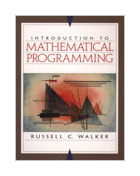1/e
Russell C. Walker , Carnegie
Mellon University
Published January 1999 by Engineering/Science/Mathematics
Copyright 1999, 560 pp.
Cloth ISBN 0-13-263765-0
Summary
Empowering users with the knowledge necessary to begin using mathematical programming as a
tool for managerial applications and beyond, this practical guide shows when a
mathematical model can be useful in solving a problem, and instills an appreciation and
understanding of the mathematics associated with the applied techniques. KEY
TOPICS:Surveys problem types, and discusses various ways to use specific mathematical
tools. Contains prerequisite material for the study of linear programming, and offers a
brief introduction to matrix algebra. Discusses the special structures of four network
problems: the transportation problem, the critical path method, the shortest path problem,
and minimal spanning trees. Covers compound interest and explores the financial aspects of
specific problems considered throughout the book. Touches on "mathematics"
oriented (vs. applications) material, with integrated proofs and discussions on such
topics basic graph theory, linear algebra, analysis, properties of algorithms, and
combinatorics. An extensive appendix section includes answers to many problems, an
introduction to the linear programming package LINDO, an overview of the symbolic
computation package Maple, and brief introductions to the TI-82 and TI-92 calculators and
their applications.
Table of Contents
1. Introduction to the Problems.
2. Vectors and Matrices.
3. Linear Programming.
4. Network Models.
5. Unconstrained Extrema.
6. Constrained Extrema.
7. Integer Programming.
8. Introduction to Dynamic Programming.
9. Case Studies.
Appendix A. A Brief Introduction to Maple.
Appendix B. Introduction to Texas Instrument Calculators.
Appendix C. Selected Answers and Hints.
Appendix D. Brief Introductions to LINDO and LINGO.
References.
Index.
Księgarnia nie działa. Nie odpowiadamy na pytania i nie realizujemy zamówien. Do odwolania !.


